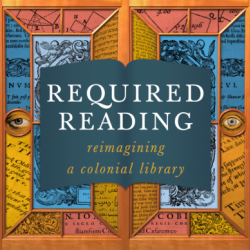
The Boston Athenæum, one of the most distinguished libraries in the US and an early Boston cultural institution founded in 1807, hosts a major exhibition showcasing and interpreting the King’s Chapel Library Collection, one of the surviving treasures of 17th century Boston.
Required Reading: Reimagining a Colonial Library will be on public view from September 2019 to 14 March 2020 in the Norma Jean Calderwood Gallery on the library’s first floor.
“Required Reading” will explore Boston’s colonial history, the fine crafts of furniture-making and bookbinding, and the quest for “essential knowledge”.
In 1698, a set of 221 books crossed the Atlantic on HMS Deptford, a fifty-gun man-of-war, to serve as a compact library of necessary works for King’s Chapel, the first Anglican church in Boston. They had been chosen by Reverend Thomas Bray of London, an appointed commissary, or spiritual guide, to Anglican outposts in the American colonies. Cached safely when the minister, loyal to the British Crown, fled Boston in March 1776, the books re-emerged after the American Revolution, and were deposited at the Athenæum in 1823.
“Required Reading” will feature a full-scale replica of the massive, ark-like bookcase designed in 1883 to house the historic collection. The replica, built in 2019 by exhibition designer Brent Budsberg of Current Projects and supported in part by the Chipstone Foundation, is an achievement in contemporary woodworking. It will be modified in a surprising way, enabling visitors to browse dozens of “must-read” works offered by the ten partners.
Founder, Dr. Thomas Bray believed his library would provide essential knowledge, yet he necessarily made book selections from a limited and biased viewpoint. Today, the Boston Athenæum collect broadly, endeavoring to reflect diverse perspectives. To demonstrate the variety and richness of “essential knowledge” and the ways it can be defined, the replica cabinet will be filled with titles from the community partners’ own “Required Reading” lists. Some authors, including James Baldwin and Toni Morrison, were chosen by multiple partners, but overlap is minimal and each list is unique.
As visitors examine compelling and important selections from the colonial library and the community partners’ lists, they will be inspired to imagine their own definitions of “required reading.”
"The story of the books’ arrival in New England as ‘necessary and useful’ texts for teaching and learning, their importance to religious leaders in Boston, and their impressive state of preservation—through the tumult of a city rocked by revolution—are dramatic and little-known,” said the Athenæum’s John Buchtel, Curator of Rare Books and Head of Special Collections. “More than three centuries later, their appeal is not simply as a time capsule or as examples of the craft of bookbinding, but also as a profound prompt, giving us the opportunity to imagine the readings we’d select as essential in our own lives.”
Highlights of the library’s holdings include the King’s Chapel Library collection, with roots in the 17th-century settlement of Boston; rare publications in Native American languages; the personal library of George Washington; historic early European printed works; and numerous works of fine art, including portraits of notable Americans such as Hannah Adams, John Marshall, and Alexander Hamilton, and by artists such as Gilbert Stuart, John Singer Sargent, Allan Rohan Crite, and Polly Thayer Starr. An extensive collection on the art of the book includes examples from many eras of bookbinding and fine printing, as well as a significant collection of contemporary artists’ books.
Rare and notable King’s Chapel Library Collection items in the exhibition include:
- An atlas of the world (1693)
- A mathematics textbook covering topics from practical geometry to logarithms (1690)
- A printer’s tour de force, the nine-language “London Polyglot” Bible (1657)
- A Biblical concordance compiled by Massachusetts minister Samuel Newman (1658)
Learn more at www.bostonathenaeum.org
